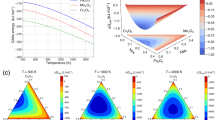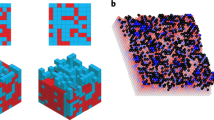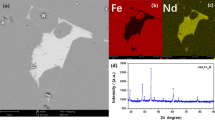Abstract
On the basis of the thermodynamic model of interaction between components (which treats a mixed oxide as a regular solution of oxide “molecules”) and the transition state theory, a quantitative model for the steady-state dissolution of a passive metal is proposed. The thermodynamic properties of the oxide and the dissolution kinetics of the passive alloy are found to correlate in a certain manner. In particular, partially modified physical concepts of the theory of regular solutions, such as an asolvotropic composition and the possibility of existence of metastable states, can also be used for describing the kinetics of the oxide dissolution. This approach enables one to understand the physical nature of those states of a system, the corrosion resistance of which is extremal, namely minimal or maximal. A scheme for comparing the results of this theory with experimental data is proposed.
Similar content being viewed by others
References
Alekseev, Yu.V.,Zashch. Met., vol. 35, no. 1, p. 20.
Moelwyn-Hughes, E.A.,Physical Chemistry, New York: Pergamon, 1961.
Zhukhovitskii, A.A. and Shvartsman, L.A.,Fizicheskaya khimiya (Physical Chemistry), Moscow: Metallurgiya, 1987.
Glasstone, S., Laidler, K., and Eyring, H.,The Theory of Rate Processes, New York, 1941.
Kolotyrkin, Ya.M. and Alekseev, Yu.A.,Zashch. Met., 1997, vol. 33, no. 1, p. 5.
Idem,,ibid.
Alekseev, Yu.A. and Kolotyrkin, Ya.M.,Elektrokhimiya, 1997, vol. 33, no. 5, p. 509.
Idem,,ibid. 1998, vol. 34, no. 1, p. 253.
Idem,,ibid., , 1995, vol. 31, no. 1, p. 263.
Novakovskii, V.M.,Zashch. Met., 1994, vol. 30, no. 2, p. 117.
Plaskeev, A.V. and Knyazheva, V.M.,ibid.,, 1994, vol. 30, no. 6, p. 565.
Alekseev, Yu.V.,Doctoral (Phys.-Math.) Dissertation, Moscow, 1990.
Alekseev, Yu.V.,Zh. Fiz. Khim., 1989, vol. 63, no. 9, p. 2578.
Idem,,ibid., , 1990, vol. 64, no. 2, p. 330.
Author information
Authors and Affiliations
Additional information
The work was financially supported by the Russian Foundation for Basic Research (project no. 99-03-32478a).
Rights and permissions
About this article
Cite this article
Alekseev, Y.V. Corrosion regularities of passive alloy in terms of a physicochemical model of mixed passivating oxide as a regular solid solution of molecules. Prot Met 36, 419–430 (2000). https://doi.org/10.1007/BF02764086
Received:
Issue Date:
DOI: https://doi.org/10.1007/BF02764086




